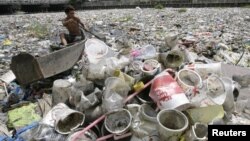Mountains of garbage could soon become a valuable source of energy in the Philippines, where waste management has long posed a serious environmental concern.
The Asian Development Bank says it is teaming up with Procter & Gamble to consider "waste-to-energy" plants that could generate up to two megawatts of power using trash from homes and businesses. The bank has approved a $385,000 technical assistance plan to help determine the viability of the plants, which could be in place by 2016.
The ADB says about 6,700 tons of solid waste is generated in metro Manila every day. It estimates that less than one-tenth of that is recycled or composted. The rest goes to dump sites, which are often prone to flooding, soil erosion, toxic spillage, and deadly garbage-slides.
In July 2000, hundreds of people were buried alive in Quezon City when heavy rains caused a 15-meter wall of trash to collapse on a squatter community living nearby. Similar deadly trash-slides have occurred in more recent years at dumpsites, which are sometimes run illegally.
ADB investment specialist Jose Manuel Limjap says the disposal of municipal solid waste is "a serious environmental and social concern." He says if the waste-to-energy program is successful in the Philippines, it could lead to similar programs elsewhere in the developing world.
Some have expressed concern that such programs, which burn trash to convert it into power, can result in toxic fumes. They also say it may reduce the incentive for recycling and other waste-minimization programs.
But Procter & Gamble, a consumer goods company, says the move is part of its long-term goal of having zero consumer or manufacturing waste go to landfills.
The Asian Development Bank says it is teaming up with Procter & Gamble to consider "waste-to-energy" plants that could generate up to two megawatts of power using trash from homes and businesses. The bank has approved a $385,000 technical assistance plan to help determine the viability of the plants, which could be in place by 2016.
The ADB says about 6,700 tons of solid waste is generated in metro Manila every day. It estimates that less than one-tenth of that is recycled or composted. The rest goes to dump sites, which are often prone to flooding, soil erosion, toxic spillage, and deadly garbage-slides.
In July 2000, hundreds of people were buried alive in Quezon City when heavy rains caused a 15-meter wall of trash to collapse on a squatter community living nearby. Similar deadly trash-slides have occurred in more recent years at dumpsites, which are sometimes run illegally.
ADB investment specialist Jose Manuel Limjap says the disposal of municipal solid waste is "a serious environmental and social concern." He says if the waste-to-energy program is successful in the Philippines, it could lead to similar programs elsewhere in the developing world.
Some have expressed concern that such programs, which burn trash to convert it into power, can result in toxic fumes. They also say it may reduce the incentive for recycling and other waste-minimization programs.
But Procter & Gamble, a consumer goods company, says the move is part of its long-term goal of having zero consumer or manufacturing waste go to landfills.









